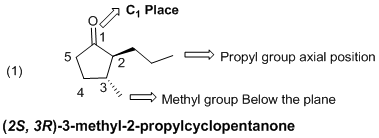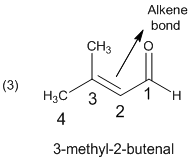
(a)
Interpretation:
The systematic (IUPAC) name of each group substituent in the given organic molecules should be draw and identified.
Concept introduction:
The several organic compounds can be named by using certain rules given by IUPAC (International Union for Pure and applied chemistry).
The IUPAC name consists of three parts in major namely Prefix, suffix and root word.
Prefix: Represents the substituent present in the molecule and its position in the root name.
For example the saturated hydrocarbons not only from only carbon-hydrogen bonds rather than the carbon-carbon bonds that have added hydrogen atoms. These
Suffix: Denotes the presence of
Root word: It represents the longest continuous carbon skeleton of the organic molecule.
To identify: The systematic (stereo chemical) name for the given molecule (a).
(a)
Explanation of Solution
Explanation

The given molecule (a) is drawn as above, in the case the carbonyl group is part of carbonyl group of a five membered ring, so the given molecule is cyclopentane-1-one. In the given molecule the parent carbon skeleton is cyclic in nature which contains of 5 carbons one keto group (-C=O). Hence root name of the molecule is ‘cyclopentane-1-one’. Since it is an alkane with five carbons, one keto then ‘1-pentanone’ will be the functional carbon chain name.
Further the molecule (a) one cyclic
Hence the systematic name for the molecule (a) is (2S, 3R)-3-methyl-2-propylcyclopentanone.
(b)
Interpretation:
The systematic (IUPAC) name of each group substituent in the given organic molecules should be draw and identified.
Concept introduction:
The several organic compounds can be named by using certain rules given by IUPAC (International Union for Pure and applied chemistry).
The IUPAC name consists of three parts in major namely Prefix, suffix and root word.
Prefix: Represents the substituent present in the molecule and its position in the root name.
For example the saturated hydrocarbons not only from only carbon-hydrogen bonds rather than the carbon-carbon bonds that have added hydrogen atoms. These alkanes have to prefix ‘cyclo’ due to the configuration of rings of carbon atoms.
Suffix: Denotes the presence of functional group if any in the molecule. It can be an alkane, alkene, alkyne, alcohol, carboxylic acid, alcohol etc. For example alkene molecules, suffix will be ‘ene’. (Or) If the presence of completely saturated alkane molecules, suffix will be ‘ane’.
Root word: It represents the longest continuous carbon skeleton of the organic molecule.
To identify: The systematic (stereo chemical) name for the given molecule (a).
(b)
Explanation of Solution
Explanation

The given molecule (b) is drawn; the parent carbon skeleton is cyclic nature which contains 6 carbons one keto group. Hence root name of the molecule is cyclohexane-1-carbaldehyde. Here given compound with six carbon atoms, one keto groups then cyclohexane
The cyclic compound containing a one aldehyde (
Hence the systematic name for the molecule (b) is ‘Cyclohexane-1-aldehyde’ (aldehyde group is connected to a six membered ring at C1 place).
(c)
Interpretation:
The systematic (IUPAC) name of each group substituent in the given organic molecules should be draw and identified.
Concept introduction:
The several organic compounds can be named by using certain rules given by IUPAC (International Union for Pure and applied chemistry).
The IUPAC name consists of three parts in major namely Prefix, suffix and root word.
Prefix: Represents the substituent present in the molecule and its position in the root name.
For example the saturated hydrocarbons not only from only carbon-hydrogen bonds rather than the carbon-carbon bonds that have added hydrogen atoms. These alkanes have to prefix ‘cyclo’ due to the configuration of rings of carbon atoms.
Suffix: Denotes the presence of functional group if any in the molecule. It can be an alkane, alkene, alkyne, alcohol, carboxylic acid, alcohol etc. For example alkene molecules, suffix will be ‘ene’. (Or) If the presence of completely saturated alkane molecules, suffix will be ‘ane’.
Root word: It represents the longest continuous carbon skeleton of the organic molecule.
To identify: The systematic (stereo chemical) name for the given molecule (a).
(c)
Explanation of Solution
Explanation

The given molecule is drawn as shown above. This compound (c) is an one aldehyde group with a parent of four carbon, so the parent should be butanol. In the given molecule the parent carbon skeleton is contains 4 carbons one double bond, which indicated by changing ‘an’ to ‘en’ as in propane into propene.
In molecule (c) parent (or) functional group is numbered so that the
Hence the systematic name for the molecule (c) is 3-methyl-2-butenal.
(d)
Interpretation:
The systematic (IUPAC) name of each group substituent in the given organic molecules should be draw and identified.
Concept introduction:
The several organic compounds can be named by using certain rules given by IUPAC (International Union for Pure and applied chemistry).
The IUPAC name consists of three parts in major namely Prefix, suffix and root word.
Prefix: Represents the substituent present in the molecule and its position in the root name.
For example the saturated hydrocarbons not only from only carbon-hydrogen bonds rather than the carbon-carbon bonds that have added hydrogen atoms. These alkanes have to prefix ‘cyclo’ due to the configuration of rings of carbon atoms.
Suffix: Denotes the presence of functional group if any in the molecule. It can be an alkane, alkene, alkyne, alcohol, carboxylic acid, alcohol etc. For example alkene molecules, suffix will be ‘ene’. (Or) If the presence of completely saturated alkane molecules, suffix will be ‘ane’.
Root word: It represents the longest continuous carbon skeleton of the organic molecule.
To identify: The systematic (stereo chemical) name for the given molecule (a).
(d)
Explanation of Solution
Explanation

The given linear molecule is drawn as shown above. The parent is a chain of six carbon atoms, with the carbonyl group at C3, so the parent is 3-hexanone. Further the identified number of substituents, above the compound is only one methyl group at C4 position.
Hence the assign a configuration to the chirality center for the molecule (d) is (S)-4-methyl-3-hexanone.
Want to see more full solutions like this?
Chapter 19 Solutions
Organic Chemistry
- Using wedge-and-dash bonds, modify the bonds on the chiral carbon in the molecule below so the molecule has R stereochemical configuration. NH H Br X टेarrow_forwardProvide photos of models of the following molecules. (Include a key for identification of the atoms) 1,2-dichloropropane 2,3,3-trimethylhexane 2-bromo-3-methybutanearrow_forwardPlease draw the structure in the box that is consistent with all the spectral data and alphabetically label all of the equivalent protons in the structure (Ha, Hb, Hc....) in order to assign all the proton NMR peaks. The integrations are computer generated and approximate the number of equivalent protons. Molecular formula: C13H1802 14 13 12 11 10 11 (ppm) Structure with assigned H peaks 2.08 3.13arrow_forward
- A 0.10 M solution of acetic acid (CH3COOH, Ka = 1.8 x 10^-5) is titrated with a 0.0250 M solution of magnesium hydroxide (Mg(OH)2). If 10.0 mL of the acid solution is titrated with 10.0 mL of the base solution, what is the pH of the resulting solution?arrow_forwardFirefly luciferin exhibits three rings. Identify which of the rings are aromatic. Identify which lone pairs are involved in establishing aromaticity. The lone pairs are labeled A-D below.arrow_forwardA 0.10 M solution of acetic acid (CH3COOH, Ka = 1.8 x 10^-5) is titrated with a 0.0250 M solution of magnesium hydroxide (Mg(OH)2). If 10.0 mL of the acid solution is titrated with 10.0 mL of the base solution, what is the pH of the resulting solution?arrow_forward
- Given a complex reaction with rate equation v = k1[A] + k2[A]2, what is the overall reaction order?arrow_forwardPlease draw the structure in the box that is consistent with all the spectral data and alphabetically label all of the equivalent protons in the structure (Ha, Hb, Hc....) in order to assign all the proton NMR peaks. The integrations are computer generated and approximate the number of equivalent protons. Molecular formula: C13H1802 14 13 12 11 10 11 (ppm) Structure with assigned H peaks 2.08 3.13arrow_forwardCHEMICAL KINETICS. One of the approximation methods for solving the rate equation is the steady-state approximation method. Explain what it consists of.arrow_forward
- CHEMICAL KINETICS. One of the approximation methods for solving the rate equation is the limiting or determining step approximation method. Explain what it consists of.arrow_forwardCHEMICAL KINETICS. Indicate the approximation methods for solving the rate equation.arrow_forwardTRANSMITTANCE เบบ Please identify the one structure below that is consistent with the 'H NMR and IR spectra shown and draw its complete structure in the box below with the protons alphabetically labeled as shown in the NMR spectrum and label the IR bands, including sp³C-H and sp2C-H stretch, indicated by the arrows. D 4000 OH LOH H₂C CH3 OH H₂C OCH3 CH3 OH 3000 2000 1500 HAVENUMBERI-11 1000 LOCH3 Draw your structure below and label its equivalent protons according to the peak labeling that is used in the NMR spectrum in order to assign the peaks. Integrals indicate number of equivalent protons. Splitting patterns are: s=singlet, d=doublet, m-multiplet 8 3Hb s m 1Hd s 3Hf m 2Hcd 2Had 1He 鄙视 m 7 7 6 5 4 3 22 500 T 1 0arrow_forward
 ChemistryChemistryISBN:9781305957404Author:Steven S. Zumdahl, Susan A. Zumdahl, Donald J. DeCostePublisher:Cengage Learning
ChemistryChemistryISBN:9781305957404Author:Steven S. Zumdahl, Susan A. Zumdahl, Donald J. DeCostePublisher:Cengage Learning ChemistryChemistryISBN:9781259911156Author:Raymond Chang Dr., Jason Overby ProfessorPublisher:McGraw-Hill Education
ChemistryChemistryISBN:9781259911156Author:Raymond Chang Dr., Jason Overby ProfessorPublisher:McGraw-Hill Education Principles of Instrumental AnalysisChemistryISBN:9781305577213Author:Douglas A. Skoog, F. James Holler, Stanley R. CrouchPublisher:Cengage Learning
Principles of Instrumental AnalysisChemistryISBN:9781305577213Author:Douglas A. Skoog, F. James Holler, Stanley R. CrouchPublisher:Cengage Learning Organic ChemistryChemistryISBN:9780078021558Author:Janice Gorzynski Smith Dr.Publisher:McGraw-Hill Education
Organic ChemistryChemistryISBN:9780078021558Author:Janice Gorzynski Smith Dr.Publisher:McGraw-Hill Education Chemistry: Principles and ReactionsChemistryISBN:9781305079373Author:William L. Masterton, Cecile N. HurleyPublisher:Cengage Learning
Chemistry: Principles and ReactionsChemistryISBN:9781305079373Author:William L. Masterton, Cecile N. HurleyPublisher:Cengage Learning Elementary Principles of Chemical Processes, Bind...ChemistryISBN:9781118431221Author:Richard M. Felder, Ronald W. Rousseau, Lisa G. BullardPublisher:WILEY
Elementary Principles of Chemical Processes, Bind...ChemistryISBN:9781118431221Author:Richard M. Felder, Ronald W. Rousseau, Lisa G. BullardPublisher:WILEY





